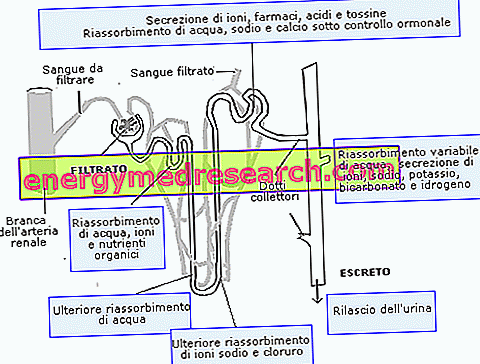Generality
Diabetes insipidus is a rare syndrome characterized by conspicuous urine emission, accompanied by an insatiable thirst with preference for cold drinks. It is due to a lack or insufficient secretion of the antidiuretic hormone (ADH or vasopressin) from the hypothalamus and the posterior pituitary, or from its lack of renal activity. In the first case we speak of central diabetes insipidus, ADH-sensitive or neurogenic, in the second of diabetes nephrogenic insipidus or ADH-insensitive (because it cannot be corrected with the administration of exogenous vasopressin).
Signs and Symptoms
To learn more: Symptoms Diabetes insipidus
Some patients affected by the disease eliminate up to 18 liters of urine per day. In normal conditions, in fact, the hormone vasopressin acts in the last section of the nephrons (distal tubules and collecting ducts), where it promotes the reabsorption of a considerable amount of water. In this way the volume of urine is reduced and their density (specific weight) is increased. In the presence of an absolute or relative vasopressin deficiency, polyuria is therefore an inevitable symptom, as is nocturia (need to urinate several times during night rest) and polydipsia (abnormal thirst). See also: Diabetes insipidus symptoms

Diabetes insipidus is well tolerated as long as the patient has enough water available; if this does not happen or the patient is unable to drink, there is a rapid dehydration, with weight loss, haemoconcentration until collapse and death.
Diagnosis
Laboratory tests show normal glucose concentrations in urine and blood, which differentiates diabetes insipidus from mellitus (mellitus because the presence of glucose in the urine makes them sweet like honey). It is recorded, due to hypernatremia and elevation of plasmatic osmolarity. As mentioned, the abundant urine shows low specific weight and osmolarity. The differential diagnosis between central and nephrogenic diabetes insipidus is based on the observation of the effects associated with the administration of exogenous ADH, which positively resolves the first but not the second form.
Causes
There are numerous causes that can induce diabetes insipidus, both in its primitive and secondary forms. At the base of this syndrome there may be, for example, rare genetic diseases or congenital malformations at the hypothalamic level (primitive forms); more frequently the central diabetes insipidus is a consequence of cranial trauma, neurosurgical interventions, infectious processes (encephalitis, meningitis) or intracranial tumors; however, in a good percentage of cases (30-40%) the cause remains unknown (idiopathic forms). Compared to the central one, nephrogenic diabetes insipidus is a very rare disease, sustained by the inability of the renal receptors to respond adequately to ADH, itself produced in normal quantities; also in this case there are congenital and acquired forms, among which we mention chronic renal failure, hypercalcemia and hypopotassemia. Finally, there may also be transitory forms, for example due to the action of substances that interfere with the action of the antidiuretic hormone.
Treatment
To learn more: Drugs for the treatment of Diabetes Insipidus
The treatment of central diabetes insipidus consists of the administration of vasopressin via the nasal, oral or subcutaneous route, which allows the regression of symptoms. In some selected cases, the treatment may be etiological and as such be based on the removal of the promoting cause (eg removal of a tumor mass).
In the presence of nephrogenic diabetes there is no medical therapy and the disease is controlled by taking large amounts of water, restricting sodium in the diet and using thiazide diuretics.



